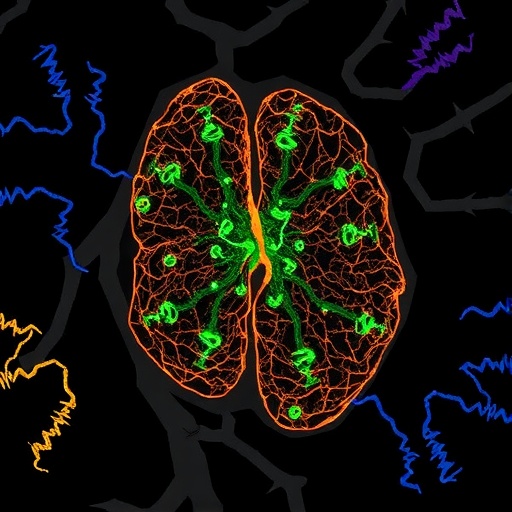In the relentless global battle against tuberculosis (TB), a disease that claims over a million lives each year, recent scientific advances are shedding unprecedented light on the intricate immune choreography that enables the human body to combat this ancient scourge. Groundbreaking research published in Nature Communications unveils a critical molecular dialogue occurring between macrophages and T cells, two essential constituents of the immune system, which fundamentally boosts the body’s defensive arsenal through the upregulation of the key receptor SLAMF1. This discovery not only clarifies a previously obscure aspect of TB immunity but also opens new avenues for therapeutic interventions aimed at enhancing host defense mechanisms.
Tuberculosis, caused by Mycobacterium tuberculosis, has long been a formidable pathogen, adept at evading immune surveillance and persisting within host cells. Central to the immune response are macrophages, the body’s professional phagocytes tasked with engulfing and destroying pathogens, and T lymphocytes, which orchestrate adaptive immunity. The study in question illuminates how interactions between these cell types intensify the expression of the Signaling Lymphocytic Activation Molecule Family 1 (SLAMF1), a receptor known for mediating immune cell communication and activation.
The complexity underlying macrophage-T cell cooperation in TB infection is highlighted by the dynamic interplay of surface receptors like SLAMF1, which function as molecular switches influencing cellular responses. SLAMF1 is a transmembrane glycoprotein expressed variably on hematopoietic cells, with roles extending beyond simple recognition to active modulation of cytokine production, cell adhesion, and pathogen clearance. The researchers demonstrate that macrophage engagement with T cells triggers a feedback loop driving SLAMF1 expression, which in turn amplifies macrophage antimicrobial functions and T cell effector capacity.
.adsslot_THstNDC6OX{ width:728px !important; height:90px !important; }
@media (max-width:1199px) { .adsslot_THstNDC6OX{ width:468px !important; height:60px !important; } }
@media (max-width:767px) { .adsslot_THstNDC6OX{ width:320px !important; height:50px !important; } }
ADVERTISEMENT
Employing state-of-the-art immunological assays, including flow cytometry and transcriptomic profiling, the scientific team documented the enhanced presence of SLAMF1 on both infected macrophages and activated T cells during M. tuberculosis challenge. This upregulation correlated strongly with increased production of key cytokines such as interferon-gamma (IFN-γ) and tumor necrosis factor-alpha (TNF-α), pivotal in boosting the microbicidal environment within the granuloma—the immunological fortress formed in TB infection.
Further mechanistic insights reveal that SLAMF1 engagement modifies intracellular signaling cascades, particularly impacting the phosphorylation states of downstream effectors involved in the NF-κB pathway and autophagy regulation. These pathways are essential for promoting the degradation of intracellular bacteria and enhancing antigen presentation, thereby fine-tuning the immune system’s capacity to detect and eradicate M. tuberculosis. The enhanced autophagic flux mediated by SLAMF1 suggests a novel connection between immune receptor signaling and cellular housekeeping processes critical for TB control.
Notably, the study underscores that the absence or diminished expression of SLAMF1 impairs the macrophage’s bactericidal activity, resulting in increased bacterial loads and attenuation of T cell responses. This finding positions SLAMF1 as a potential biomarker for immune competence against TB and highlights its therapeutic potential in boosting host immunity, particularly in individuals with compromised immune systems, such as those co-infected with HIV or suffering from malnutrition.
The researchers utilized sophisticated in vitro co-culture models of human macrophages and T cells, mimicking the granulomatous microenvironment, to dissect the nuances of cell-cell interactions driving SLAMF1 expression. Their data demonstrated that direct contact between these cells, rather than soluble factors alone, was critical for robust receptor induction, pointing to a contact-dependent signaling axis as a vital component of immune synergy in TB defense.
These findings resonate deeply within the larger context of immune checkpoint biology, where molecules such as PD-1 and CTLA-4 have dominated attention. SLAMF1 now emerges as a complementary molecular player with the capacity to modulate immune activation positively, rather than inhibit it, thus representing a novel target that enhances immunity instead of dampening it. Such a perspective shift could inspire the development of next-generation immunotherapies designed to invigorate rather than suppress immune responses in infectious diseases.
Moreover, the temporal kinetics of SLAMF1 expression unveiled a critical window during the course of infection—initially low but profoundly elevated upon T cell priming—which suggests that SLAMF1 may serve a dual role in both early innate immune activation and subsequent adaptive immune amplification. This biphasic function highlights the receptor’s importance in orchestrating the transition from innate to adaptive immunity, a process pivotal in determining TB infection outcomes.
In the broader immunological landscape, the intricate interplay between macrophages and T cells mediated by SLAMF1 adds a compelling layer of complexity to our understanding of host-pathogen interactions. It is now evident that the immune system’s efficacy depends not solely on the presence of individual cell types but on their precise molecular dialogues, which govern the quality, magnitude, and longevity of the immune response.
Importantly, this research provides a foundation for exploring SLAMF1-centric strategies in TB vaccine development. Current vaccine formulations, including Bacille Calmette-Guérin (BCG), have limited efficacy in adults, and enhancing SLAMF1 signaling might potentiate vaccine-induced immunity by fostering stronger macrophage-T cell engagement and more robust memory T cell responses.
The implications of this study extend beyond TB, potentially informing therapies for other intracellular infections where macrophage-T cell interactions are paramount. Given SLAMF1’s role in modulating immune cell activation and autophagy, similar mechanisms may operate in infections like leishmaniasis, HIV, and even some viral diseases, positioning SLAMF1 as a versatile immunomodulatory target.
Furthermore, this research enriches our conceptual frameworks about granuloma biology—a pathological hallmark of TB that both contains infection and provides a niche for bacterial persistence. Fine-tuning SLAMF1 expression could recalibrate granuloma dynamics, ensuring effective containment without compromising tissue integrity, an elusive balance crucial for successful TB control.
Though the therapeutic promise is compelling, translating these insights into clinical interventions demands careful consideration. Targeting immune pathways bears the risk of exacerbating inflammation or precipitating autoimmunity. Hence, future studies must delineate the precise regulatory networks governing SLAMF1 activity to design interventions that maximize benefit while minimizing adverse effects.
In sum, this research unravels a vital molecular mechanism by which macrophages and T cells collaborate through SLAMF1 expression, enhancing the immune response against Mycobacterium tuberculosis. By elucidating the complex signaling interactions and functional ramifications of this receptor’s regulation, scientists have identified a promising target for boosting host defenses in TB and potentially other intracellular infections. This paradigm-shifting discovery reaffirms the importance of dissecting cellular crosstalk at a molecular level to inform the design of next-generation immunotherapies and vaccines.
Subject of Research: The study investigates macrophage-T cell interactions and the regulation of SLAMF1 expression to enhance immune defense mechanisms against tuberculosis.
Article Title: Macrophage-T cell interactions promote SLAMF1 expression for enhanced TB defense.
Article References:
Krishna Prasad, G.V.R., Grigsby, S.J., Erkenswick, G.A. et al. Macrophage-T cell interactions promote SLAMF1 expression for enhanced TB defense. Nat Commun 16, 6794 (2025). https://doi.org/10.1038/s41467-025-61826-7
Image Credits: AI Generated
Tags: enhancing host defense against TBimmune cell communication in TBimmune system choreography against infectionsmacrophage T cell interactions in tuberculosismacrophages and T lymphocytes cooperationmolecular dialogue in immune responseMycobacterium tuberculosis evasion strategiesphagocytosis and adaptive immunitysignaling lymphocytic activation molecule familySLAMF1 role in immune responsetherapeutic interventions for tuberculosistuberculosis immune defense mechanisms






